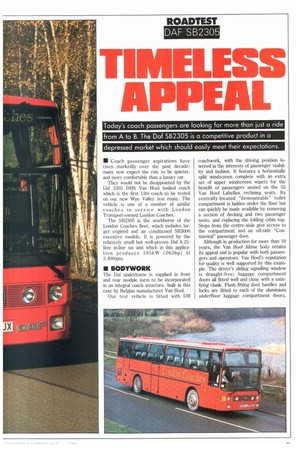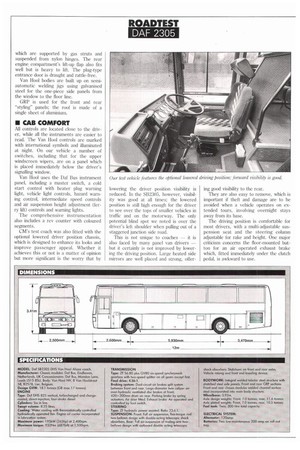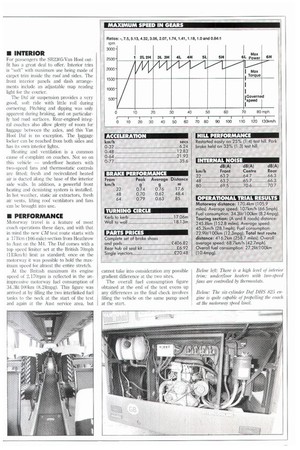TIMELESS APPEAL
Page 27

Page 28

Page 29

Page 30

If you've noticed an error in this article please click here to report it so we can fix it.
Today's coach passengers are looking for more than just a ride from A to B. The Daf SB2305 is a competitive product in a depressed market which should easily meet their expectations.
• Coach passenger aspirations have risen markedly over the past decade: many now expect the ride to be quieter, and more comfortable than a luxury car.
They would not be disappointed by the Daf 2305 DHS Van Hool bodied coach which is the first 12m coach to be tested on our new Wye Valley test route. The vehicle is one of a number of similar coaches in service with London Transport-owned London Coaches.
The SB2305 is the workhorse of the London Coaches fleet, which includes larger engined and air conditioned SH3000 executive models. It is powered by the relatively small but well-proven Daf 8.25litre in-line six unit which in this application produces 19 5kW (265hp) at 2,40Orpm.
• BODYWORK
The Daf underframe is supplied in front and rear module form to be incorporated in an integral coach structure, built in this case by Belgian manufacturer Van Hool.
Our test vehicle is fitted with DH coachwork, with the driving position lowered in the interests of passenger visibility and fashion. It features a horizontally split windscreen complete with an extra set of upper windscreen wipers for the benefit of passengers seated on the 53 Van Hool Labellux reclining seats. Its centrally-located "demountable" toilet compartment is hidden under the floor but can quickly be made available by removing a section of decking and two passenger seats, and replacing the folding cabin top. Steps from the centre aisle give access to the compartment and an off-side "Continental" passenger door.
Although in production for more than 10 years, the Van Hool Alizee body retains its appeal and is popular with both passengers and operators. Van Hool's reputation for quality is well supported by this example. The driver's sliding signalling window is draught-free; luggage compartment doors all fitted well and close with a satisfying clunk. Flush fitting door handles and locks are fitted to each of the aluminium underfloor luggage compartment doors, which are supported by gas struts and suspended from nylon hinges. The rear engine, compartment's lift-up flap also fits well but is heavy to lift. The plug-type entrance door is draught and rattle-free.
Van Hoot bodies are built up on semiautomatic welding jigs using galvanised steel for the one-piece side panels from the window to the floor line.
GRP is used for the front and rear "styling" panels; the roof is made of a single sheet of aluminium.
• CAB COMFORT
Al] controls are located close to the driver, while all the instruments are easier to read. The Van Hool controls are marked with international symbols and illuminated at night. On our vehicle a number of switches, including that for the upper windscreen wipers, are on a panel which is placed immediately below the driver's signalling window.
Van Hoot uses the Daf Bus instrument panel, including a master switch, a cold start control with heater plug warning light, vehicle light controls, hazard warning control, intermediate speed controls and air suspension height adjustment (ferry lift) controls and warning lights.
The comprehensive instrumentation also includes a rev counter with coloured segments.
CM's test coach was also fitted with the optional lowered driver position chassis, which is designed to enhance its looks and improve passenger appeal. Whether it achieves this or not is a matter of opinion but more significant is the worry that by lowering the driver position visibility is reduced. In the SB2305, however, visibility was good at all times; the lowered position is still high enough for the driver to see over the tops of smaller vehicles in traffic and on the motorway. The only potential blind spot we noted is over the driver's left shoulder when pulling out of a staggered junction side road.
This is not unique to coaches — it is also faced by many panel van drivers — but it certainly is not improved by lowering the driving position. Large heated side mirrors are well placed and strong, offer
ing good visibility to the rear.
They are also easy to remove, which is important if theft and damage are to be avoided when a vehicle operates on extended tours, involving overnight stays away from its base.
The driving position is comfortable for most drivers, with a multi-adjustable suspension seat and the steering column adjustable for rake and height. One major criticism concerns the floor-mounted button for an air operated exhaust brake which, fitted immediately under the clutch pedal, is awkward to use.
• INTERIOR
For passengers the SB2305/Van Hool outfit has a great deal to offer, Interior trim is "soft" with maximum use being made of carpet trim inside the roof and sides. 'Ile front interior panels and dash arrangements include an adjustable map reading light for the courier.
The Daf air suspension provides a very good, soft ride with little roll during cornering. Pitching and dipping was only apparent during braking, and on particularly bad road surfaces. Rear-engined integral coaches also allow plenty of room for luggage between the axles, and this Van Hool Dal is no exception. The luggage locker can be reached from both sides and has its own interior lights.
Heating and ventilation is a common cause of complaint on coaches. Not so on this vehicle underfloor heaters with two-speed fans and thermostatic controls are fitted; fresh and recirculated heated air is ducted along the base of the interior side walls. In addition, a powerful front heating and demisting system is installed. In hot weather, static air extractors, fresh air vents, lifting roof ventilators and fans can be brought into use.
• PERFORMANCE
Motorway travel is a feature of most coach operations these days, and with that in mind the new CM test route starts with a 171km (106-mile) section from Heathrow to Aust on the M4. The Daf comes with a top speed limiter set at the British 70mph (113km/h) limit as standard; once on the motorway it was possible to hold the maximum speed for almost the entire stretch.
Al the British maximum its engine speed of 2.170rpm is reflected in the unimpressive motorway fuel consumption of 34.31iti 100km (8.24mpg). This figure was arrived at by filling the two interlinked fuel tanks to the neck at the start of the test and again at the Aust service area, but
cannot take into consideration any possible gradient difference at the two sites.
The overall fuel consumption figure obtained at the end of the test evens up any differences as the final check involves filling the vehicle on the same pump used at the start.
Below left: There is a high level of interiiw trim; underfloor heaters with Iwo-speed fans are controlled by thermostats.
At motorway speeds in high ratio top gear the coach is stable, quiet and unfussed, yet returned the remarkably high average speed of 107krnih (66.5mph).
From Aust the CM route takes us over the Severn bridge and on to the A466 past the ruins of Tintern Abbey and through the picturesque Wye Valley. This winding A-road brought down our overall speed significantly and allowed full appreciation of the positive brakes and excellent powered steering.
By making full use of the ZF S6.80 synchromesh gearbox and splitter it is possible to keep the SB2305's engine operating at its optimum speeds within the rev counter's green economy band.
The gear change on the familiar ZF box is a little heavy and not as precise as offered by some other coaches. For most starts second gear low ratio is more than adequate, leaving first gear (which does not have the splitter connected) for tough gradients.
From the driver's seat it is not possible to hear the engine clearly. This increases the importance of the rev counter — and the possibility of unintentional abuse by making clutch slipping and third gear starts less apparent to an inexperienced driver.
From the A466 our test route takes the steep, winding A4136 into the Forest of Dean and along B-roads through more Wye Valley scenery before joining the A40 near Ross. On rounding a corner during a steep climb. towards the Forest from Monmouth, we found the road covered by a thin layer of mud, as the result of road works. A rear end slide was just Perceptible but the coach responded well and proved easy to control.
The route continues along the A40 and other trunk roads to bypass Cheltenham and head towards Oxford where urban traffic conditions are encountered. From Oxford it heads back to the M4 via a popular coaching route, the A423 through Henley-on-Thames to Maidenhead and back to the start near Heathrow.
The final part of the test was covered at night, which gave us a chance to assess the lights on the vehicle. They are impressive. Twin. extra main beam head lights are mounted in the front grille, and side lights are incorporated in the outer (dipped and main beam) headlights.
There are also six marker lights along the lower side panels as well as the more usual roof marker lights.
On this, the touring section of route, the Daf returned a much improved fuel consumption of 22.9litilOOkm (12.3mpg) to bring the overall fuel consumption to a more respectable 27.21W100km (10.4mpg) at a relaxed average speed of 68.7kmih (42.7mph). Throughout the test the coach was driven at the relevant speed limits, subject to road and traffic conditions.
It could well prove worthwhile to opt for the larger engined Daf SB3000 model if a lot of 70inph motorway work is envis aged. On the other hand on the "touring" section of the test route the fuel con sumption was competitive and the flexibility of the 8.25-litre engine makes the SB2305 DKS a very attractive vehicle for tour operators.
• SUAVAARY
For the operator the Van Hool Daf combination offers the well known benefits of Daf back-up and the possibility of ex tended warranty packages and maintenance contracts. The Van Hool product also provides good access for maintenance and includes features such as lift up wheel arches to allow work on suspension units and dampers. Quality coachwork also increases passenger appeal and prolongs vehicle life. Van Hool's current T range Alizee styling is well known and is as fresh now as it was 10 years ago, making it perfectly possible to disguise a vehicle's age by the use of "cherished" number plates.
The Daf SB2305 DKS Van Hool DH is a well-mannered and attractive vehicle that will please its driver, passengers and operator. It is a competitive product that, in a currently depressed market, will have the ability to stay the course and stand the test of time. In a market where true prices start at £100,000 and the deal available dictates the buying decision, this Daf is worthy of consideration when compared with all its main touring coach rivals.
by Noel Millier




































































